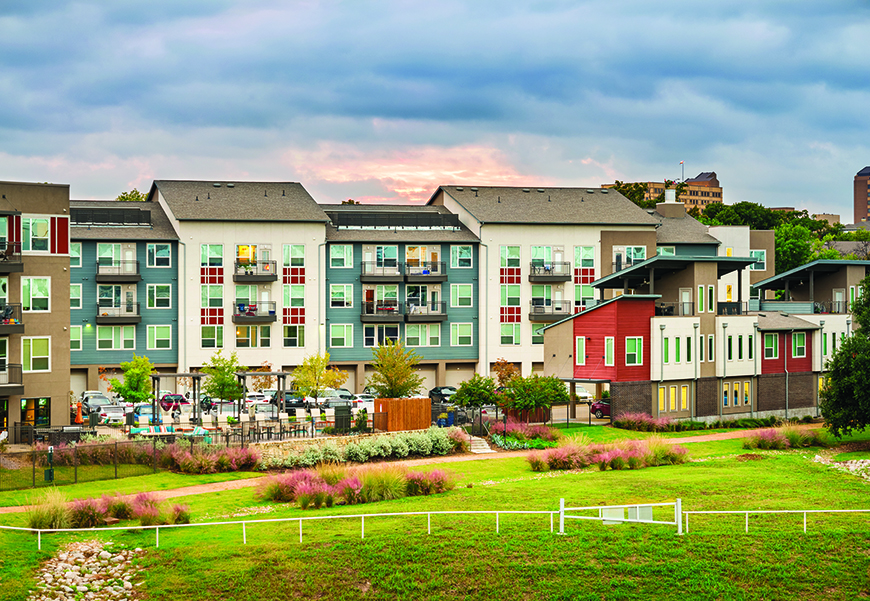
Texas Quarterly Apartment Report

Click here to receive email notifications each time this report is published.

Texas Economic Overview
Employment growth continued through the first quarter of the year. Economic activity within Texas improved during 1Q2022, although joblessness in the Lone Star State was still higher than the national average. The variance in unemployment rate performance between the state and the nation is largely explained by the outsized recovery of Texas’ labor force participation rate relative to the country’s as a whole. Oil industry activity accelerated as oil prices increased, and global economic recovery continued. The large wave of COVID cases throughout the country didn’t translate to a similar wave of illness or deaths and appeared to have a minimal impact on consumer behavior and the continued return to pre-pandemic conditions.
Texas nonfarm employment added 166,300 jobs through the first quarter. Total nonfarm employment in Texas has now continued well past the pre-COVID peak of just under 13 million jobs to just over 13.2 million jobs.
Austin added 12,900 employees, continuing a strong recovery as the metro benefits from its substantial high-tech sector, which can socially distance and has prospered during the pandemic.
Employment increased in Dallas and Fort Worth, gaining 56,700 and 16,600 jobs, respectively.
Hiring in Houston again saw strong growth, adding 32,400 jobs during the first quarter. However, payrolls remain below pre-pandemic levels.
San Antonio registered a quarterly increase of 5,300 workers.
Texas’ goods-producing sector gained 38,900 jobs during the fourth quarter following a gain of 26,500 positions in the previous quarter. Amid increasing oil prices, energy-related employment rose by 8,900 jobs. Recovering global economic conditions supported the state’s manufacturing industry, which added 13,800 employees, while durable-goods payrolls recorded an 8,400-job gain. Construction payrolls expanded this quarter, adding 16,200 jobs.
Texas’ service-providing sector added 166,500 workers. Leisure/hospitality recouped 44,500 jobs, but arts/entertainment/recreation payrolls remained almost 10 percent below pre-pandemic levels. On the other hand, the transportation/warehousing/utilities industry added 29,800 positions, with total employment now surpassing pre-pandemic employment by 4 percent.
As it has become increasingly clear that inflation is not so transitory and the Federal Reserve has continued raising rates, the costs of capital has begun to rise. The ten-year U.S. Treasury bond yield quarterly average increased to 1.95 percent through the first quarter, up from 4Q2021’s 1.53 percent and 4Q2019’s 1.7 percent. The spread between apartment capitalization rates and the ten-year Treasury yield decreased through the quarter. This was due to an increase in the yield for the ten-year Treasury bill. Overall apartment cap rates for Houston and San Antonio remain the highest, followed by DFW and Austin.
Texas’ unemployment rate decreased to 4.6 percent, still greater than the national rate of 3.8 percent. The size of the state’s labor force expanded while the labor force participation rate reached 63.4 percent. Texas’ major metros reported lower unemployment rates than the statewide average, except in Houston where joblessness fell to 5.1 percent. Unemployment fell to 3.8 percent in DFW and to 4 percent in San Antonio. Joblessness remained lowest in Austin, where unemployment slid to 3.1 percent.
The longer unemployment rates remain elevated, the more they negatively impact multifamily vacancies and rents. As expected, the increase in unemployment with the recession pushed up vacancy rates in the major metros. Declining unemployment rates have been associated with falling vacancy rates (Figures 5-8). The reopening of the economy, accompanied by strong job growth, has contributed to decreasing vacancy rates. Going forward, the forecast calls for continued decreases in vacancy and increases in rent.
TRERC estimated 2022 and 2023 apartment vacancy rates and effective rent percent changes for the major MSAs (Tables 1 and 2).










For an analysis of Austin’s, DFW’s, Houston’s, and San Antonio’s apartment markets (including tables, figures, and maps), download the full report.
Previous reports available:
2021: 1Q2021, 2Q2021, 3Q2021, 4Q2021

You might also like

Publications
Receive our economic and housing reports and newsletters for free.





